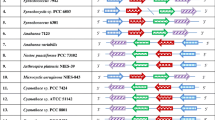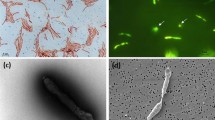Abstract
At present geological epoch, the carbon concentrating mechanism (CCM) of cyanobacteria represents the obligatory tool for adaptation to low content of CO2 in the atmosphere and for the maintenance of sufficient photosynthetic activity. Functional CCM was found in modern cyanobacteria from different ecological niches. However, the presence of such mechanism in species that inhabit soda lakes is not obvious due to high content of inorganic carbon (C i) in the environment. Here we analyze CCM components that have been identified by sequencing of the whole genome of the alkaliphilic cyanobacterium Microcoleus sp. IPPAS B-353. The composition of the CCM components of Microcoleus is similar to that of ‘model’ β-cyanobacteria, freshwater and marine Synechococcus or Synechocystis spp. However, CahB1 protein of Microcoleus, which is the homolog of CcaA, the carboxysomal β-type carbonic anhydrase (CA) of β-cyanobacteria, appeared to be the only active CA located in cell envelopes. The conservative regions of CcmM, CahG (a homolog of archeal γ-CAs, Cam/CamH), and ChpX of Microcoleus possess single amino acid substitutions that may cause a lack of CA activities. Unlike model cyanobacteria, Microcoleus induces only one BicA-type bicarbonate transporter in response to C i limitation. The differences in the appearance of CCM components and in their characteristics between alkaliphilic Microcoleus and freshwater or marine cyanobacteria are described. The possible reasons for the maintenance of CCM components in cyanobacteria, which permanently live at high concentrations of C i in soda lakes, are discussed.







Similar content being viewed by others
Abbreviations
- CA:
-
Carbonic anhydrase
- CCM:
-
CO2-concentrating mechanism
- C i :
-
Inorganic carbon compounds (CO2 + HCO3 −)
- K m :
-
Michaelis constant
- RuBisCO:
-
Ribulose-1,5-bisphosphate carboxylase/oxygenase
References
Alber BE, Ferry JG (1994) A carbonic anhydrase from the archaeon Methanosarcina thermophila. Proc Natl Acad Sci USA 91:6909–6913. doi:10.1073/pnas.91.15.6909
Badger M, Price GD, Long BM, Woodger FJ (2006) The environmental plasticity and ecological genomics of the cyanobacterial CO2 concentrating mechanism. J Exp Bot 57:249–265. doi:10.1093/jxb/eri286
Battchikova N, Vainonen JP, Vorontsova N, Keranen M, Carmel D, Aro EM (2010) Dynamic changes in the proteome of Synechocystis 6803 in response to CO2 limitation revealed by quantitative proteomics. J Proteome Res 9:5896–5912. doi:10.1021/pr100651w
Berner RA (2003) The long-term carbon cycle, fossil fuels and atmospheric composition. Nature 426:323–326. doi:10.1038/nature02131
Blank CE, Sánchez-Baracaldo P (2010) Timing of morphological and ecological innovations in the cyanobacteria: a key to understanding the rise of atmospheric oxygen. Geobiology 8:1–23. doi:10.1111/j.1472-4669.2009.00220.x
Cameron JC, Wilson SC, Bernstein SL, Kerfeld CA (2013) Biogenesis of a bacterial organelle: the carboxysome assembly pathway. Cell 155:1131–1140. doi:10.1016/j.cell.2013.10.044
Cannon GC, Heinhorst S, Kerfeld CA (2010) Carboxysomal carbonic anhydrases: structure and role in microbial CO2 fixation. Biochim Biophys Acta 1804:382–392. doi:10.1016/j.bbapap.2009.09.026
Cho SM, Jeoung SC, Song JY, Kupriyanova EV, Pronina NA, Lee BW, Jo SW, Park BS, Choi SB, Song JJ, Park YI (2015) Genomic survey and biochemical analysis of recombinant candidate cyanobacteriochromes reveals enrichment for near UV/Violet sensors in the halotolerant and alkaliphilic cyanobacterium Microcoleus IPPAS B353. J Biol Chem 290:28502–28514. doi:10.1074/jbc.M115.669150
Cot SS, So AK, Espie GS (2008) A multiprotein bicarbonate dehydration complex essential to carboxysome function in cyanobacteria. J Bacteriol 190:936–945. doi:10.1128/JB.01283-07
De Araujo C, Arefeen D, Tadesse Y, Long BM, Price GD, Rowlett RS, Kimber MS, Espie GS (2014) Identification and characterization of a carboxysomal γ-carbonic anhydrase from the cyanobacterium Nostoc sp. PCC 7120. Photosyn Res 121:135–150. doi:10.1007/s11120-014-0018-4
Dudoladova MV, Kupriyanova EV, Markelova AG, Sinetova MP, Allakhverdiev SI, Pronina NA (2007) The thylakoid carbonic anhydrase associated with photosystem II is the component of inorganic carbon accumulating system in cells of halo- and alkaliphilic cyanobacterium Rhabdoderma lineare. Biochim Biophys Acta 1767:616–623. doi:10.1016/j.bbabio.2006.12.006
Eisenhut M, von Wobeser EA, Schubert H, Ibelings BW, Bauwe H, Matthijs HC, Hagemann M (2007) Long-term response toward inorganic carbon limitation in wild type and glycolate turnover mutants of the cyanobacterium Synechocystis sp. strain PCC 6803. Plant Physiol 144:1946–1959. doi:10.1104/pp.107.103341
Espie GS, Kandasamy RA (1994) Monensin inhibition of Na+-dependent HCO3 − transport distinguishes it from Na+-independent HCO3 − transport and provides evidence for Na+/HCO3 − symport in the cyanobacterium Synechococcus UTEX 625. Plant Physiol 104:1419–1428. doi:10.1104/pp.104.4.1419
Espie GS, Kimber MS (2011) Carboxysomes: cyanobacterial RubisCO comes in small packages. Photosynth Res 109:7–20. doi:10.1007/s11120-011-9656-y
Ferry JG (2010) The gamma class of carbonic anhydrases. Biochim Biophys Acta 1804:374–381. doi:10.1016/j.bbapap.2009.08.026
Folea IM, Zhang P, Nowaczyk MM, Ogawa T, Aro EM, Boekema EJ (2008) Single particle analysis of thylakoid proteins from Thermosynechococcus elongatus and Synechocystis 6803: localization of the CupA subunit of NDH-1. FEBS Lett 582:249–254. doi:10.1016/j.febslet.2007.12.012
Gaudana SB, Zarzycki J, Moparthi VK, Kerfeld CA (2015) Bioinformatic analysis of the distribution of inorganic carbon transporters and prospective targets for bioengineering to increase Ci uptake by cyanobacteria. Photosynth Res 126:99–109. doi:10.1007/s11120-014-0059-8
Gerasimenko LM, Mityushina LL, Namsaraev BB (2003) Microcoleus mats from alkaliphilic and halophilic communities. Microbiology (Moscow) 72:71–79. doi:10.1023/A:1022282124104
Giordano M, Beardall J, Raven JA (2005) CO2 concentrating mechanism in algae: mechanisms, environmental modulation, and evolution. Annu Rev Plant Biol 56:99–131. doi:10.1146/annurev.arplant.56.032604.144052
Green MR, Sambrook J (2012) Molecular cloning: a laboratory manual, 4th edn. Cold Spring Harbor Laboratory Press, New York
Kasting JF (1987) Theoretical constraints on oxygen and carbon dioxide concentrations in the Precambrian atmosphere. Precambrian Res 34:205–229. doi:10.1016/0301-9268(87)90001-5
Kinney JN, Axen SD, Kerfeld CA (2011) Comparative analysis of carboxysome shell proteins. Photosynth Res 109:21–32. doi:10.1007/s11120-011-9624-6
Konhauser K (2009) Deepening the early oxygen debate. Nat Geosci 2:241–242. doi:10.1038/ngeo484
Kupriyanova EV, Samylina OS (2015) CO2-concentrating mechanism and its traits in haloalkaliphilic cyanobacteria. Microbiology (Moscow) 84:144–159. doi:10.7868/S0026365615010073
Kupriyanova E, Villarejo A, Markelova A, Gerasimenko L, Zavarzin G, Samuelsson G, Los DA, Pronina N (2007) Extracellular carbonic anhydrases of the stromatolite-forming cyanobacterium Microcoleus chthonoplastes. Microbiology 153:1149–1156. doi:10.1099/mic.0.2006/003905-0
Kupriyanova EV, Sinetova MA, Markelova AG, Allakhverdiev SI, Los DA, Pronina NA (2011) Extracellular β-class carbonic anhydrase of the alkaliphilic cyanobacterium Microcoleus chthonoplastes. J Photochem Photobiol B 103:78–86. doi:10.1016/j.jphotobiol.2011.01.021
Laemmli UK (1970) Cleavage of structural proteins during the assembly of the head of bacteriophage T4. Nature 227:680–685. doi:10.1038/227680a0
Maeda S, Badger MR, Price GD (2002) Novel gene products associated with NdhD3/D4-containing NDH-1 complexes are involved in photosynthetic CO2 hydration in the cyanobacterium, Synechococcus sp. PCC7942. Mol Microbiol 43:425–435. doi:10.1046/j.1365-2958.2002.02753.x
Marshall OJ (2004) PerlPrimer: cross-platform, graphical primer design for standard, bisulphite and real-time PCR. Bioinformatics 20:2471–2472. doi:10.1093/bioinformatics/bth254
McGinn PJ, Price GD, Maleszka R, Badger MR (2003) Inorganic carbon limitation and light control the expression of transcripts related to the CO2-concentrating mechanism in the cyanobacterium Synechocystis sp. strain PCC6803. Plant Physiol 132:218–229. doi:10.1104/pp.019349
Mikhodyuk OS, Zavarzin GA, Ivanovsky RN (2008) Transport systems for carbonate in the extremely natronophilic cyanobacterium Euhalothece sp. Microbiology (Moscow) 77:412–418. doi:10.1134/S002626170804005X
Namsaraev ZB, Gorlenko VM, Dulov LE, Sorokin VV, Buryukhaev SP, Barkhutova DD, Dambaev VD, Namsaraev BB (2010) Water regime and variations in hydrochemical characteristics of the soda Salt Lake Khilganta (Southeastern Transbaikalia). Water Res 37:513–519. doi:10.1134/S009780781004010X
Omata T, Price GD, Badger MR, Okamura M, Gohta S, Ogawa T (1999) Identification of an ATP-binding cassette transporter involved in bicarbonate uptake in the cyanobacterium Synechococcus sp. strain PCC7942. Proc Natl Acad Sci USA 96:13571–13576. doi:10.1073/pnas.96.23.13571
Peña KL, Castel SE, De Araujo C, Espie GS, Kimber MS (2010) Structural basis of the oxidative activation of the carboxysomal gamma-carbonic anhydrase, CcmM. Proc Natl Acad Sci USA 107:2455–2460. doi:10.1073/pnas.0910866107
Price GD (2011) Inorganic carbon transporters of the cyanobacterial CO2 concentrating mechanism. Photosynth Res 109:47–57. doi:10.1007/s11120-010-9608-y
Price GD, Maeda S, Omata T, Badger MR (2002) Modes of active inorganic carbon uptake in the cyanobacterium, Synechococcus sp. PCC7942. Funct Plant Biol 29:131–149. doi:10.1071/PP01229
Price GD, Woodger FJ, Badger MR, Howitt SM, Tucker L (2004) Identification of a SulP-type bicarbonate transporter in marine cyanobacteria. Proc Natl Acad Sci USA 101:18228–18233. doi:10.1073/pnas.0405211101
Price GD, Badger MR, Wodger FJ, Long BM (2008) Advances in understanding the cyanobacterial CO2-concentrating mechanism (CCM): functional components, Ci transporters, diversity, genetic regulation and prospects for engineering into plants. J Exp Bot 59:1441–1461. doi:10.1093/jxb/erm112
Raven JA, Cockell CS, De La Rocha CL (2008) The evolution of inorganic carbon concentrating mechanisms in photosynthesis. Philos Trans R Soc Lond B Biol Sci 363:2641–2650. doi:10.1098/rstb.2008.0020
Rippka R (1988) Isolation and purification of cyanobacteria. Methods Enzymol 167:3–27. doi:10.1016/0076-6879(88)67004-2
Sergeev VN, Gerasimenko LM, Zavarzin GA (2002) The proterozoic history and present state of cyanobacteria. Microbiology (Moscow) 71:623–637. doi:10.1023/A:1021415503436
Shibata M, Katoh H, Sonoda M, Ohkawa H, Shimoyama M, Fukuzawa H, Kaplan A, Ogawa T (2002) Genes essential to sodium-dependent bicarbonate transport in cyanobacteria. Function and phylogenetic analysis. J Biol Chem 277:18658–18664. doi:10.1074/jbc.M112468200
So AKC, Espie GS (2005) Cyanobacterial carbonic anhydrases. Can J Bot 83:721–734. doi:10.1139/b05-057
So AKC, Van Spall HGC, Coleman JR, Espie GS (1998) Catalytic exchange of 18O from 13C18O-labelled CO2 by wild type cells and ecaA, ecaB, and ccaA mutants of the cyanobacteria Synechococcus PCC7942 and Synechocystis PCC6803. Can J Bot 76:1153–1160. doi:10.1139/b98-063
Soltes-Rak E, Mulligan ME, Coleman JR (1997) Identification and characterization of gene encoding a vertebrate-type carbonic anhydrase in cyanobacteria. J Bacteriol 179:769–774
Wang HL, Postier BL, Burnap RL (2004) Alterations in global patterns of gene expression in Synechocystis sp. PCC 6803 in response to inorganic carbon limitation and the inactivation of ndhR, a LysR family regulator. J Biol Chem 279:5739–5751. doi:10.1074/jbc.M311336200
Wilbur KM, Anderson NG (1948) Electrometric and colorimetric determination of carbonic anhydrase. J Biol Chem 176:147–154
Williams JGK (1988) Construction of specific mutations in photosystem II photosynthetic reaction center by genetic engineering methods in Synechocystis 6803. Methods Enzymol 167:766–778. doi:10.1016/0076-6879(88)67088-1
Woodger FJ, Badger MR, Price GD (2003) Inorganic carbon limitation induces transcripts encoding components of the CO2: concentrating mechanism is Synechococcus sp. PCC7942 through a redox-independent pathway. Plant Physiol 133:2069–2080. doi:10.1104/pp.103.029728
Woodger FJ, Bryant DA, Price GD (2007) Transcriptional regulation of the CO2-concentrating mechanism in a euryhaline, coastal marine cyanobacterium, Synechococcus sp. strain PCC 7002: role of NdhR/CcmR. J Bacteriol 189:3335–3347. doi:10.1128/JB.01745-06
Xu M, Ogawa T, Pakrasi HB, Mi H (2008) Identification and localization of the CupB protein involved in constitutive CO2 uptake in the cyanobacterium, Synechocystis sp. strain PCC6803. Plant Cell Physiol 49:994–997. doi:10.1093/pcp/pcn074
Zavarzin GA (2008) Microbial Biosphere. In: Dobretsov NL, Kolchanov NA, Rosanov AY, Zavarzin GA (eds) Biosphere origin and evolution. Springer Science + Business Media, LLC, New York, pp 25–42
Zimmerman SA, Tomb JF, Ferry JG (2010) Characterization of CamH from Methanosarcina thermophila, founding member of a subclass of the γ-class of carbonic anhydrases. J Bacteriol 192:1353–1360. doi:10.1128/JB.01164-09
Acknowledgments
We thank Prof. J. Eaton-Rye (University of Otago, Dunedin, New Zealand) and Dr. M.P. Malakhov (San Diego, USA) for critical reading of the manuscript; we are grateful to M.V. Rodionova for the help during the experiments on overexpression of CahB1 protein. D.A.L and E.V.K were supported by a grant from Russian Science Foundation (no. 14-24-00020); N.A.P. was supported by a grant from Russian Foundation for Basic Research (no. 13-04-00193a); Y.I.P. was supported by grants from the Next-Generation BioGreen 21 Program, Rural Development Administration (PJ011659) and the Advanced Biomass R&D Center (ABC) of Korea (NRF-2011-0031344), the Ministry of Science, ICT and Future Planning, Korea.
Author information
Authors and Affiliations
Corresponding author
Electronic supplementary material
Below is the link to the electronic supplementary material.
Rights and permissions
About this article
Cite this article
Kupriyanova, E.V., Cho, S.M., Park, YI. et al. The complete genome of a cyanobacterium from a soda lake reveals the presence of the components of CO2-concentrating mechanism. Photosynth Res 130, 151–165 (2016). https://doi.org/10.1007/s11120-016-0235-0
Received:
Accepted:
Published:
Issue Date:
DOI: https://doi.org/10.1007/s11120-016-0235-0




